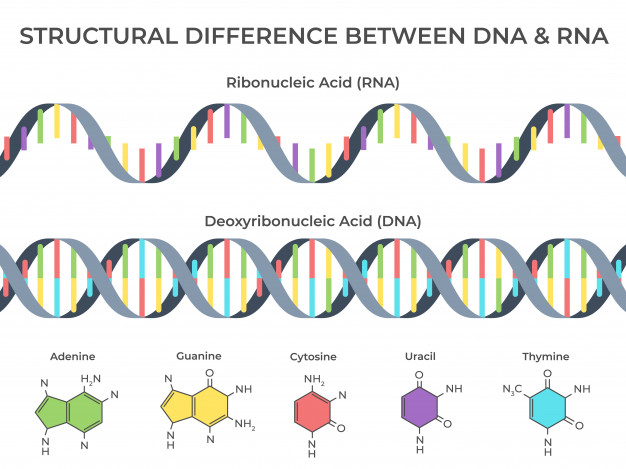From single-celled protozoans to complex multicellular plants and animals, life on Earth is extremely diverse. However, all life is essentially made up of the same building blocks – DNA and RNA – at the molecular level.
DNA is double-stranded, while RNA is single-stranded. This is one of the main differences between DNA and RNA.

The most important molecules in cell biology are deoxyribonucleic acid (DNA) and ribonucleic acid (RNA), which are responsible for the storing and reading of genetic material that underpins all life. They’re both linear polymers made up of sugars, phosphates, and bases, although there are some significant variations between them. These differences enable the two molecules to collaborate and perform their vital functions.
Differences between DNA and RNA
| DNA | RNA |
| The full Form is Deoxyribonucleic Acid. | The full Form is Ribonucleic Acid. |
| All genetic information is encoded in DNA, which serves as the blueprint for all biological life. In the long run, DNA serves as a storage unit, | A biological flash drive that allows the life blueprint to be passed down across generations2. This flash drive is decoded by RNA, which acts as a reader. This reading process is multi-step, with different RNAs for each step. |
| The sugar in DNA is called deoxyribose. | The sugar in RNA is simply called ribose. |
| DNA has a single hydrogen atom. | RNA has two hydroxyls (-OH) groups attached to its carbon backbone |
| The deoxyribose sugar gives DNA more stability. | The extra hydroxyl group in RNA aids in the conversion of genetic code to mRNAs, which can then be translated into proteins. |
| The nitrogen bases in DNA are the basic units of genetic code, and they must be ordered and paired correctly for biological function. Adenine (A), thymine (T), guanine (G), and cytosine (C) are the four bases that make up this code (C). | Thymine bases are absent in RNA, and they are replaced by uracil bases (U), which pair with adenine1. |
| The two-stranded structure of DNA is well-known thanks to Francis Crick and James Watson’s DNA double helix. | RNA’s single-stranded structure is less well-known. As mRNA and tRNA molecules pair during translation, RNA can form double-stranded structures. |
| DNA polymers are also much longer than RNA polymers; the human genome is made up of 46 chromosomes, each of which is a single, long DNA molecule. | In contrast, RNA molecules are much shorter. |
What are the different three types of RNA?
Messenger RNA (mRNA) copies parts of genetic code and transports them to ribosomes, which are the cellular factories that help produce proteins from this code.

In response to the coded instructions introduced by the mRNA, transfer RNA (tRNA) transfers amino acids, the essential protein building blocks, to these protein factories. The method of constructing proteins is known as translation.
Finally, ribosomal RNA (rRNA) is a part of the ribosome factory, and protein development would not be possible without it.
Conclusion
There is some proof DNA may have existed first, but most scientists think RNA evolved before DNA. RNA has a straightforward structure and is required for DNA to work. Also, RNA is formed in prokaryotes, which are supposed to come before eukaryotes. RNA on its own can function as a catalyst for specific chemical reactions.
The real concern is why DNA developed if RNA occurred. The most probable answer for this is that possessing a double-stranded molecule works for protecting the genetic code from damage. If one strand is halted, the other strand can work as a template for repair.
If you have any questions regarding this blog post, then please let us know your concerns in the comment section.





